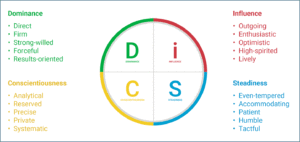I would like to introduce you to your new colleague, Diane. You will be working closely with her. Diane scares the hell out of some people. She knows what she wants, tells you exactly what she thinks and has little patience for aimless chit chat. Diane will enjoy collaborating with you. As long as you do things her way. She wants to hear your opinion. You have about 19 seconds. She thrives on team activities. Assuming she is the team leader. I’m just kidding (sort of).
In this month’s installment on mastering workplace relationships by leveraging the DiSC© personality model, we explore the Dominance (D) personality style. Those with a D personality are often seen as confident and assertive leaders who drive teams to success. However, if not harnessed correctly, this personality style can intimidate others and shut down collaboration. Read on to learn how to harness the power of workplace personality dynamics.
DiSC© Personality Styles
A quick review of the four major personality styles (D – i – S – C) can be found below. As you can see, The D style is assertive and likes to get stuff done. Look at how the D style compares with the other three personalities.

People with the D style are strong-willed individuals who prioritize getting results. Because they want to make their mark, they constantly look for new challenges and opportunities. They tend to be action-oriented, so they often focus on achieving their goals quickly and forcefully.
The D style is often very fast-paced. They like it when people cut to the chase and don’t waste time with details that distract from the goal. They speak up when they see a problem and are quick to execute on solutions. Because they want to control outcomes, they’re often questioning and independent-minded.
If You are a D Style
As with all personality styles, the D Style can run into trouble in relationships – if they aren’t careful. They tend to judge others by their ability to achieve results. This can bring out an insistent, competitive side that is more focused on winning than relationships. When under pressure, they can become impatient and demanding. This can intimidate others and cause them to shut down or even harbor resentments. This dynamic can undermine collaboration and lead to win-lose situations.
If you are a D style, try to build your self-awareness. Take time to reflect on how you are perceived by others. You may even ask those close to you how you come off. Sometimes, the fear of being taken advantage of or appearing weak can cause you to behave contentiously or lack empathy and patience. You may get your way – but at what cost?
The D style can increase their workplace effectiveness by practicing some of the following:
- Be more tolerant of relaxed, less assertive, and more amiable personality styles
- Develop genuine empathy – listen to understand rather than to respond
- Cultivate patience for reaching the best solution rather than the fastest solution
- Avoid burnout by learning to train, delegate to, and empower others
- Tone down your language and nonverbal communication; think before you speak
Although the D can be a natural leader, dialing back the intensity and practicing a gentler communication style will build stronger relationships and drive better results in the long term.
If you Work with a D Style
If you work with a D style and want to communicate and interact with them more effectively, try the following approaches:
- Remember that the D Style places an emphasis on accomplishing results
- Don’t get intimidated or take their assertive approach personally
- Talk to them about the big picture and the bottom line rather than getting into details
- Be willing to move quickly when needed – even if all the details aren’t settled
- Take a firm stance and speak concisely when presenting your ideas
Remember that the D style can be extraordinarily effective at creating success in the workplace. Their focus on the goal can move teams and projects forward – and provide confidence to overcome obstacles. When you adapt to their approach and help them see the importance of relationships, they can be a driving force for success.
In our next installment, we will explore the i-style in the DiSC© model. If you would like more information on how to harness the power of workplace personality dynamics in your organization, email doug@thebeckleygroup.com today.
